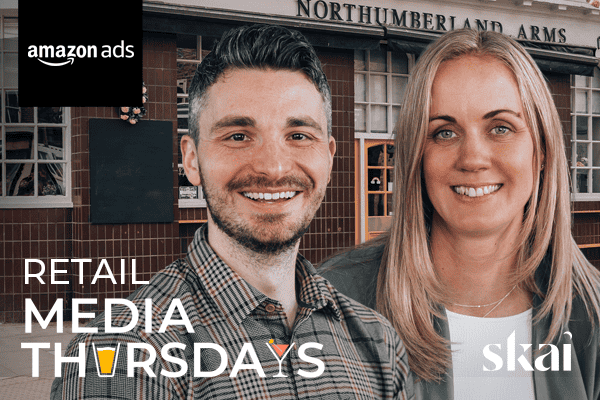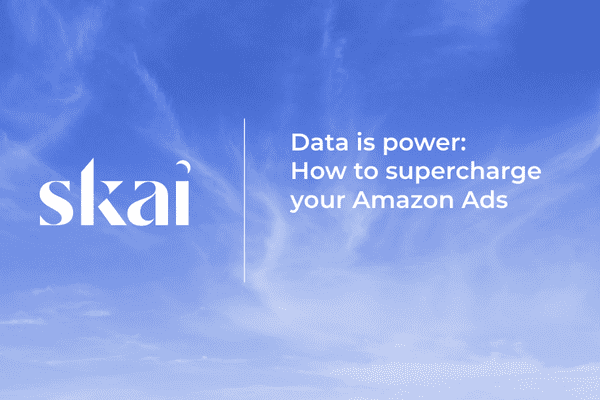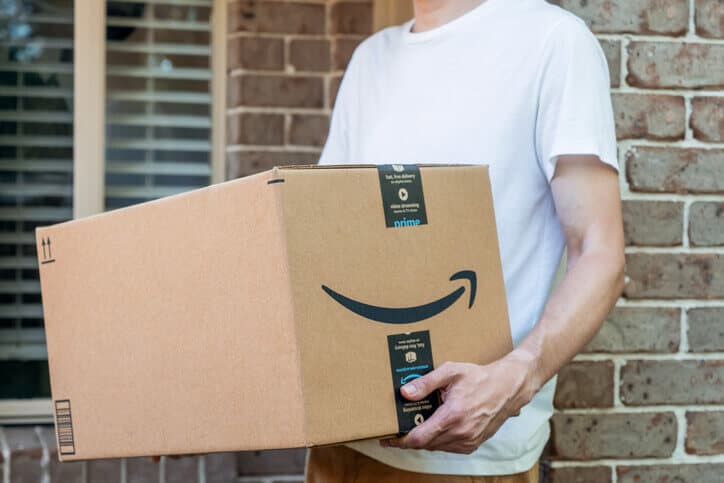
Amazon, Walmart, Target, and Kroger. There are literally hundreds of major players in the retail media game, and it can be super challenging for companies to know where to place their ads
With more ecommerce marketplace options available to third-party sellers than ever before, it can be difficult to determine the best avenue to connect with the most relevant customers and conduct successful sales.
The retail media marketplace competition is perpetually growing, featuring huge companies like Amazon and smaller online retailers making a big name for themselves, like Etsy. Amazon stands at a level above other retailers in the space, owning more than 80 percent of the retail media spend worldwide.
In this complete guide, we explore what Amazon Ads is, its benefits, how it works, and how you can start advertising with Amazon, as well as a few of the key differences between advertising with Amazon and one of its top competitors: Walmart Connect. Start at the beginning, or feel free to jump around by using our table of contents:
TABLE OF CONTENTS
- What Is Amazon Ads?
- What are the Types of Amazon Ads?
- What Are the Benefits of Amazon Ads?
- How Do Amazon Ads Work?
- How to Create a Strategy For Amazon Ads
What Is Amazon Ads?
Amazon Ads is a marketing channel for brands and third-party sellers to advertise by paying for digital advertising space on Amazon.com and the greater online Amazon ecosystem. Amazon’s retail media platform gives sellers access to shoppers online, on the mobile app, and in stores.
What are the different types of Amazon Ads?
- Sponsored Products: Self-service, cost-per-click (CPC) ads for individual product listings that appear in shopping results and on product detail pages.
- Sponsored Brands: Self-service, cost-per-click ads for brands that appear in shopping results and feature a custom headline, brand logo, and multiple products.
- Sponsored Display: Self-service display ads that use automatically generated ad creatives and are targeted to audiences created based on relevant Amazon shopping interests.
- Stores: Free, multi-page brand destinations on Amazon that feature your product portfolio and help tell your brand story.
- Audio ads: Ads that play on the free tier of Amazon Music across Alexa-enabled devices, including Echo and Fire TV, as well as on mobile and desktop.
- Video ads: Streaming TV ads that appear on connected TVs, publisher channels and networks, IMDb, and IMDb TV. Out-stream video ads appear outside of video content, both on and off Amazon.
- Custom advertising: Tailor-made advertising experiences that are created together with Amazon Ads account executives.
- Amazon DSP: Amazon’s demand-side platform enables advertisers to programmatically buy display, video, and audio ads.
- Amazon Attribution: This product measures how non-Amazon ads media drive results on Amazon. Non-endemic advertisers, those note necessarily selling products on Amazon, can still advertise products and services.
- Amazon Marketing Cloud (AMC): A data-clean room where brands can track their buyers throughout the customer journey, basically bringing reporting together, on and off Amazon products.
- Amazon Marketing Stream: Data streaming service that partners can subscribe to and get access to Amazon Ads campaign metrics.

Most U.S.-based retail media networks are anticipated to increase in prioritization in 2023 with Amazon being the most prioritized followed by Walmart, Target, and Instacart. SOURCE: Skai, ‘State of Retail Media 2023’ report
What Are the Benefits of Amazon Ads?
There are a number of retail advertising options for brands, but there are some unique benefits of Amazon Ads that make it a top choice.
Meet customers where they are
More shoppers have moved to online shopping than ever before. eMarketer estimates that the U.S. share of online sales has jumped from 11% in 2019 to 14% in 2021. Retail media is dominating the way customers find the product they want, so why not meet them where they are with prompt answers to their questions and solutions to their needs?
Advertise with the best
Forbes reported that 74% of U.S. shoppers begin their product searches on Amazon. In addition, Amazon accounts for 76.2% of U.S. ecommerce ad spending. Whether they purchase from a third-party seller online or not, online product listings, reviews, and retail media help consumers make their final purchase decision. And with Amazon taking up so much space for consumers and advertisers, it only makes sense to utilize its platform.
Customize your ads
Amazon recognizes that there is no one-size-fits-all formula that works for every retailer. With this in mind, Amazon Ads offers a selection of customizable features, including a variety of creative ad formats and advertising placements. You can customize your budget based on what you want to spend and who you want to target.
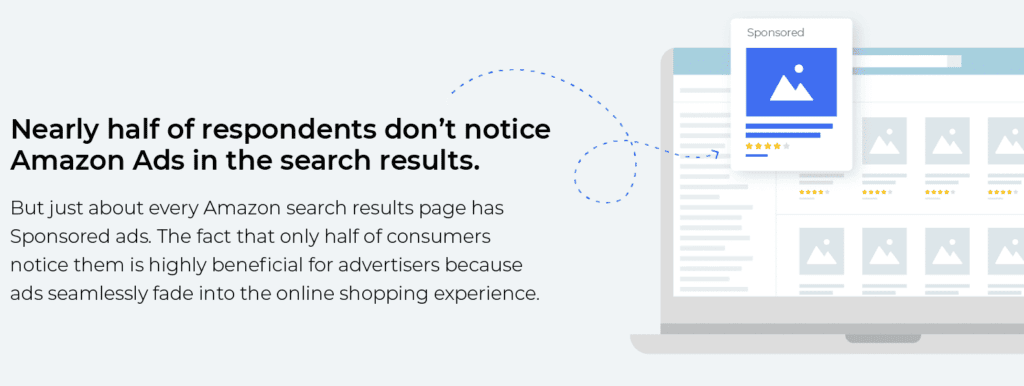
How Does Amazon Ads Work?
Amazon PPC
Amazon PPC ad models are great for advertisers because they only pay when a user clicks an ad. The metrics it measures include:
Advertising Cost of Sales (ACoS)
The percent of attributed sales spent on advertising. This is calculated by dividing total ad spend by attributed sales. For example, if you spent $4 on advertising resulting in attributed sales of $20, your ACoS would be 20% (ie. $4/$20 = 0.20).
Attributed Sales
The total product sales generated within one week of clicks on your ads. Your sales data can take up to 48 hours to populate so, as a result, sales data is not available in the ‘Today’ date range and may be delayed to the ‘Yesterday’ date range. You can view the individual sales totals for advertised products and other products in the Campaign Performance report.
Impressions
The number of times your ads were displayed. Once identified, it may take up to three days to remove invalid clicks from your reports. Clicks from the last three days may be adjusted due to click invalidation.
Clicks
The number of times your ads were clicked. Once identified, it may take up to three days to remove invalid clicks from your reports. Clicks from the last three days may be adjusted due to click invalidation.
 Amazon Sponsored Products and Brands
Amazon Sponsored Products and Brands
- Sponsored Products: Cost-per-click (CPC) ads that promote individual product listings on Amazon.
- Sponsored Brands: Cost-per-click ads that promote your entire brand in relevant search results on Amazon.
Automated and manual campaigns
- Automated targeting campaigns: Automatic targeting is the easiest and quickest way to get started. Amazon does the work for you, matching your ads to shopping queries and products.
- Manual campaigns: For advertisers with more targeting experience, manual targeting gives you greater control over when and where your ads appear. With manual targeting, you can choose the specific keywords and products you wish to target and set bids accordingly.
Keyword bidding
When a shopper searches for products on Amazon, Amazon Ads runs a real-time, CPC auction to determine: (a) which ads to serve, if any; and (b), the order in which those ads will be served.
We mentioned Amazon Ads uses a second-bid auction process, but more specifically, Amazon Ads uses an enhanced Second-Price Auction which selects and ranks eligible ads by evaluating both the target-level bid and the relevance to the matched query. This means that the auction winner may not necessarily need to bid the highest to win the first placement as relevance can introduce a discount factor.
Learn more about how to win in Retail Media.
How to Create a Strategy for Amazon Ads
There are so many details throughout Amazon Ads that it can be tricky to know where to start and how to develop a solid strategy. Here’s how to prioritize your Amazon Ads strategy to create the most successful campaigns.
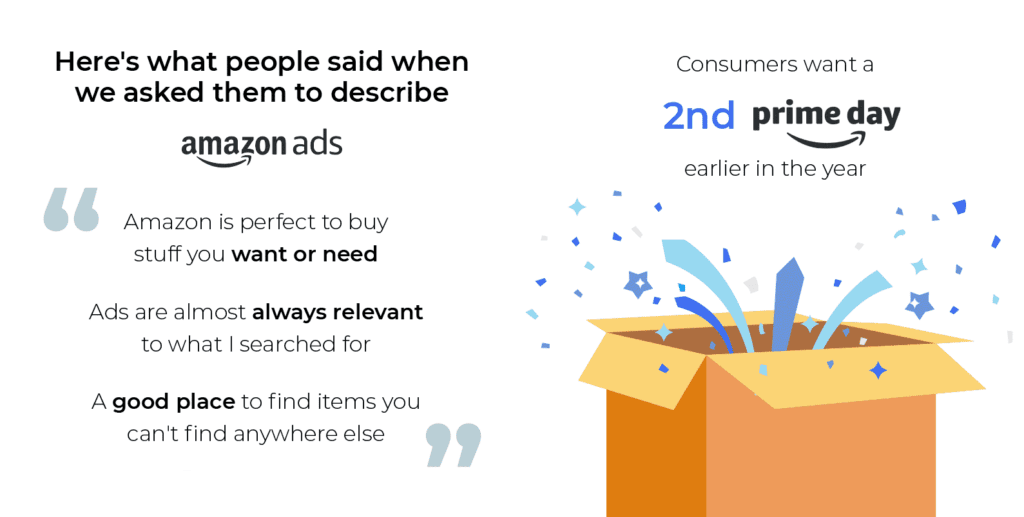
1. Master Sponsored Products
These ads appear based on keywords, and businesses can choose which keywords prompt their ads or allow Amazon to suggest search terms to target the ad. To master Sponsored Products, it’s critical that you not only understand the right product keywords for your target audience, but also what competitive and complementary products align with your offering.
2. Master Sponsored Brands
Sponsored Brands are keyword-targeted ads that feature the brand’s logo, a custom headline, and up to three product listings. These ads appear within search results and generally at the top of the page. An important piece of mastering Sponsored Brands is to have a deep understanding of brands that both compete with and complement your brand, and how all of these elements align with what your audience searches for.
3. Including keywords in product listings
When creating a product listing to appeal to both buyers and to Amazon’s search algorithm, the keywords in the product title are critical. Try to include as many keywords as possible without sacrificing clarity.
4. Ensure product listing descriptions are accurate and robust
All of the words used in titles and product descriptions should be informative and focused on the benefits of the product. For example, why would a searcher want a “12-pocket hanging wall planter” over other, similar “planters?” Make sure your descriptions are accurate and easy to read, and also sell your item.
5. Use high-quality images
Make sure all pictures of your products follow Amazon’s guidelines, which call for high-quality images of at least 1,000 pixels or larger. It’s also important to keep your images focused on the product being sold. And be sure the image listed on Amazon is an accurate representation of what the product looks like in real life. Reviewers won’t hold back if they feel the image and the product are not aligned.
6. Garner positive reviews
Reviews have a significant impact on the conversion of users initially motivated by your ads.
Even if you’ve invested heavily in Amazon search advertising, it’s a good idea to always have one eye on your business’s organic search results as well. And on Amazon, an abundance of good reviews is a great way to get to the top of SERPs.
You can have the most beautiful, highly targeted ad, but if the product is generating negative reviews, the quality of the ad won’t matter.
7. Use a tool to manage your campaigns
Begin with the basics: build a campaign with the new tools and get it ready to go live. From there, get your customer support team involved! Have them look at the campaign before it launches just to make sure everything is a go. And once the campaign is live, test out some of those more advanced new features in order to see how they work in action.
How do I get help with Amazon Ads?
As part of Skai’s marketing platform, our Retail Media solution empowers brands to plan, execute, and measure digital campaigns that meet consumers when and where they shop. Built with best-in-class automation and optimization capabilities, our unified ecommerce solution allows you to manage campaigns on 80+ retailers including Amazon, Walmart, Target, and Instacart all in one place. Ready to learn more? Check out Skai’s Retail Media solution.

 Amazon Sponsored Products and Brands
Amazon Sponsored Products and Brands


